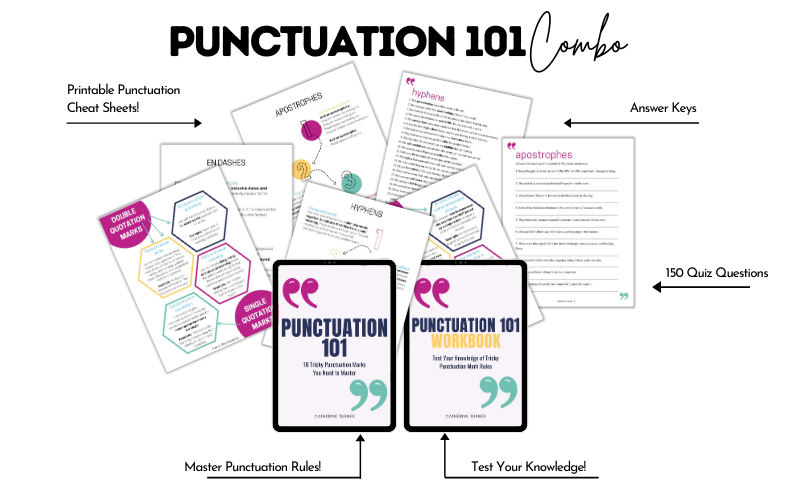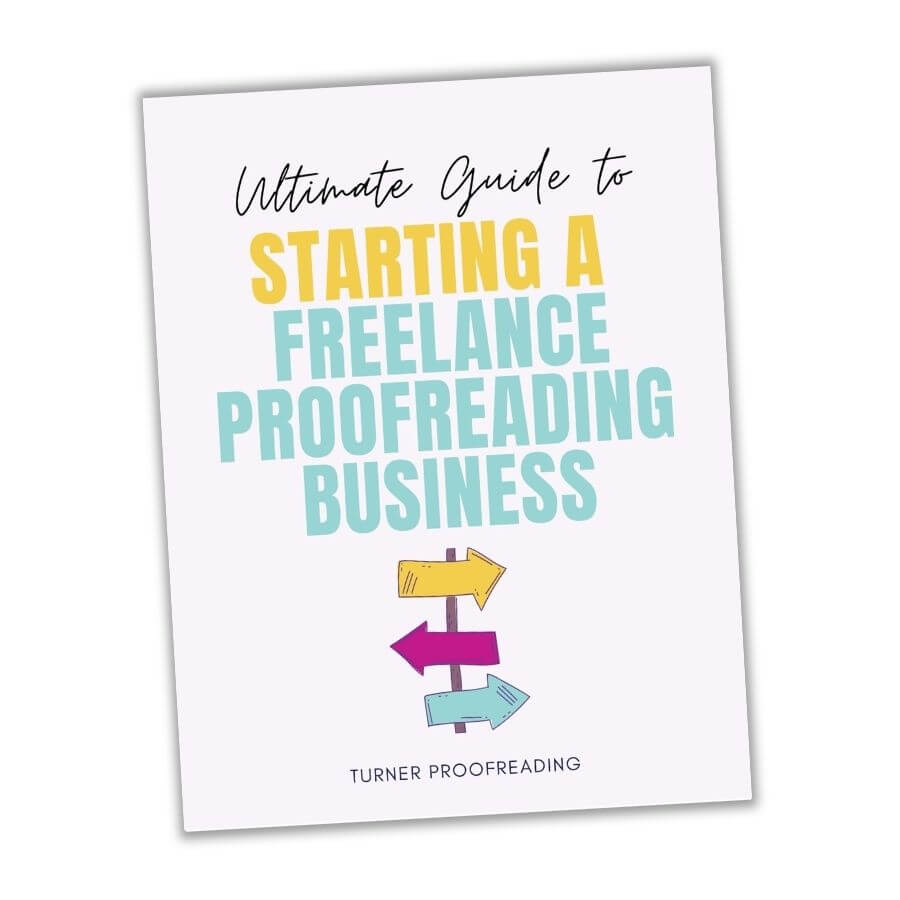This content may contain affiliate links. If you purchase through these links I may receive a commission at no extra cost to you. However, I only recommend products or services that I genuinely like and trust.
Do you know how to use quotation marks correctly?
What is the difference between single quotes vs. double quotes?
Can you use quotation marks for emphasis?
Speech marks trip some people up because how you use them can depend on where your audience is based. They are used differently in British English vs. American English.
I explain how to use quotation marks below, how they are often misused, and the difference between single and double quotation marks.
(Please note that I used The Chicago Manual of Style (CMOS) as my reference guide unless otherwise noted.)
What are quotation marks?
Quotation marks are used to mark the beginning and the end of dialogue or a direct quotation. They are used with some titles such as a chapter of a book or an individual TV episode. They can also be used to indicate irony or an unusual meaning.
Quotation marks are also known as speech marks, or in British English, inverted commas. They always come in pairs. Every open quotation mark requires a closing one.
What do quotation marks look like?
There are two types of quotation marks: single (‘ ’) and double (“ ”). Which one you use depends on which style guide you follow.
Directional quotation marks (sometimes called “smart” or “curly”) should be used in published work as opposed to the unidirectional mark that can sometimes appear (“).
Where can you find the single and double quote symbols on a keyboard?
You’ll find them on the apostrophe/quotation mark key to the left of the enter/return key.
To get the double quotation marks symbol, hold down the shift key and press the apostrophe/quotation mark key to the left of the enter/return key.
If you want to use the numeric codes, you can press and hold the alt key, then type the four-digit character code on the numeric keypad.
Single quotation marks or apostrophe:
Use ALT+0145 for the left single quotation mark or apostrophe.
Use ALT+0146 for the right single quotation mark or apostrophe.
Double quotation marks:
Use ALT+0147 for the left double quotation marks.
Use ALT+0148 for the right double quotation marks.
What is the difference between single and double quotation marks?
The most notable difference between single and double quotation marks is that they are used differently in British English vs. American English.
If you are writing in American English, you will use double quotation marks the majority of the time with one exception that I’ll outline below.
If you are writing in British English, you will use single quotation marks the majority of the time. However, some publications like certain newspapers use double quotation marks for quotes.
What are double quotation marks used for?
There are only three main rules or uses for double quotation marks.
Use quotation marks for dialogue or direct quotations
Quotation marks are used with direct quotes; that is, the exact words a person said or wrote.
Examples:
Peter said, “I have every intention of doing some exercise today.”
“Yeah, right,” said Jack. “I’ll believe it when I see it!”
Longer quotations that are broken into paragraphs are treated as follows: use opening quotation marks at the beginning of each new paragraph but only use a closing quotation mark after the very last word of the entire quotation.
Use quotation marks for titles of certain works
Quotation marks should be used with the following title types:
- Book chapter titles
- Individual episodes of TV or radio shows
- Articles in periodicals
- Stories
- Poems
- Songs
- Individual pages of websites
- Individual blog posts
- Unpublished lectures or speeches
Examples:
I used to be able to recite every single word of the poem “The Owl and the Pussy-Cat.”
My favorite episode of Friends is “The One with the Embryos.”
Note that the title of the TV show is italicized rather than placed in quotes.
Use quotation marks to indicate irony or an unusual meaning
Quotation marks can be used to indicate slang, irony, and unusual meaning where the author wants to signify that the word or phrase in question is being used in a questionable manner.
Examples:
Her mother told her her unemployed boyfriend was a real “catch.”
The politician listened to their woes to show them he “cares.”
Can you use quotation marks for emphasis? CMOS doesn’t recommend using quotation marks for emphasis, recommending the use of italics instead.
Some style guides recommend setting words discussed as words in quotation marks; however, CMOS recommends italics instead.
What are single quotation marks used for?
Single quotes only have one function in American English: to indicate a quotation within a quotation.
Use single quotes to indicate a quotation within a quotation
Single quotation marks are used for a quotation within a quotation. In American English, the outside quotation marks are double quotation marks, and the inner quotation marks are single.
Example:
“ ‘Someone Like You’ is my favorite song from Adele’s 21 album,” said Catherine.
In British English, you would reverse the order of the quotation marks; that is, the outside quotation marks will be single, and the inner quotation marks will be double.
Example:
‘ “Someone Like You” is my favorite song from Adele’s 21 album,’ said Catherine.
It can be difficult to see a single quotation mark when it’s followed by a double quote, so typesetters often add a thin space between the two.
Related content:
How to Use an Ellipsis: Chicago vs. AP Style
En Dash vs. Em Dash: When and How to Use Them
How to Use an Apostrophe (and Mistakes You Need to Avoid)
Colon vs. Semicolon: When and How to Use Them
How to Use Commas (and Mistakes to Avoid)
15 Essential Reference Books for New Proofreaders
How should quotation marks be punctuated?
You probably have some questions about how to treat quotation marks in relation to other punctuation.
Do periods go inside quotation marks?
When should punctuation be outside of quotation marks?
It varies depending on the punctuation mark. Some punctuation marks go inside the quotation marks and some remain outside.
Here’s the breakdown:
Periods and commas always go inside closing quotation marks, regardless of whether double or single quotes are used.
Question marks and exclamation points should be placed outside quotation marks unless they’re part of the quoted sentence.
Colons, semicolons, and dashes go outside closing quotation marks.
Avoid using unnecessary quotation marks
Many people, especially on social media, use quotation marks on words they want to emphasize. If you want to emphasize a word, it would be better to use italics or bold.
Misused quotation marks can produce some hilarious sentences.
Examples:
“Congratulations” on the birth of your new baby!
Do they not really mean congratulations?
Congratulations on the birth of your new “baby”!
What are they implying? That you gave birth to a puppy or an alien?
We sell “fat-free” cookies here!
So they do have fat in them?
Employees “must” wash hands!
Eww! So they don’t really have to then?
Grammar Posts
Different From vs. Different Than
Quotation marks quiz
Can you spot any quotation mark errors in the below sentences? (Based on the Chicago Manual of Style recommendations outlined in this blog post.)
Use the knowledge you’ve learned above and try not to peek at the answers below!
- “Thank you” for your generous gift.
- Her favorite Wordsworth poem is “I Wandered Lonely as a Cloud;” she reads it often.
- Anne said, “If you don’t get over here right now, I’m going to chase you”!
- “Are we there yet,” he asked?
- Mary asked, “Are you sure John said “There’s only room for the two of us””?
Want to Learn More about Tricky Punctuation Issues?
Are you always worried that you’re not punctuating sentences correctly? Or you want to be a proofreader, but you’re worried your punctuation skills aren’t up to scratch? We all learned how to use commas, semicolons, etc. once upon a time, but information doesn’t always stick that well, and sometimes we hold on to incorrect information!
My Punctuation 101 e-book and workbook combo will help you refresh your memory of punctuation rules, learn the mistakes you need to avoid making, and polish your punctuation skills so you can wow your readers and clients.
It includes tons of example sentences so you can see the punctuation marks in action AND 150 quiz questions to help you retain that knowledge forever.

Further Reading
- The Chicago Manual of Style
- New Oxford Style Manual
- The Associated Press Stylebook
- Merriam-Webster Collegiate Dictionary
- The Best Punctuation Book, Period

Quotation marks quiz answers
- Thank you for your generous gift. (Quotation marks aren’t necessary here.)
- Her favorite Wordsworth poem is “I Wandered Lonely as a Cloud”; she reads it often. (Semicolons go outside closing quotation marks)
- Anne said, “If you don’t get over here right now, I’m going to chase you!” (The exclamation mark is part of the quoted sentence, so it goes inside the quotes.)
- “Are we there yet?” he asked. (The question mark is part of the quoted sentence, so it goes inside the quotes.)
- Mary asked, “Are you sure John said ‘There’s only room for the two of us’?” (This is a quote inside a quote, so use single quotes around the inner quote.)


